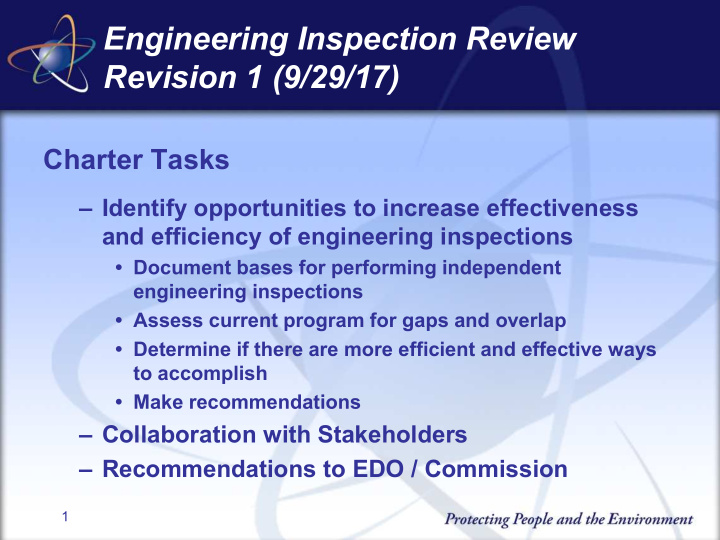



Engineering Inspection Review Revision 1 (9/29/17) Charter Tasks – Identify opportunities to increase effectiveness and efficiency of engineering inspections • Document bases for performing independent engineering inspections • Assess current program for gaps and overlap • Determine if there are more efficient and effective ways to accomplish • Make recommendations – Collaboration with Stakeholders – Recommendations to EDO / Commission 1
Engineering Inspection Review Principal Considerations – Ensure that NRC independent oversight is appropriate (transformational approach, what to inspect, how often, depth, agility of samples) – Emphasize inspection focus on current performance and introduction of latent issues 2
Engineering Inspection Review What the team has completed so far • Why the NRC conducts independent engineering inspections • What activities licensees perform that could result in the introduction of latent conditions • What inspections we currently perform 3
Engineering Inspection Review What the team has completed so far • What inspections could be performed to improve the effectiveness of our oversight • What immediate efficiencies can be implemented to achieve NRC independent oversight objectives 4
Engineering Inspection Review Working Group Observations (Current Inspection Program) • Why? – Latent conditions… • Many engineering activities that could introduce latent conditions • Independent NRC oversight of a wide range of engineering activities 5
Engineering Inspection Review Working Group Observations (Current Inspection Program) • Some current inspection procedures need not be standalone (goals can be achieved through sample selection) • Current sample selection can contribute to perceptions of re- inspection (there exists opportunity for improved agility) • Existing program does not give credit to licensee’s who conduct thorough self-assessments 6
Engineering Inspection Review Current Working Group Alignment – Heat sink engineering inspection (focused sample) – In-service inspection (focus improvements) – Boric acid inspection (sample) – Improve engineering inspection agility – 10 CFR 50.59 inspection (incorporate) – Improve fire protection inspection agility 7
Engineering Inspection Review Important Decision Points – Inspection Cycle (i.e., Quadrennial vs. Triennial) – Fire Protection Inspection – Comprehensive Engineering Inspection – Credit for Industry Self-Assessment – Other possibilities (indicators, etc.) 8
Engineering Inspection Review Key Considerations for Self Assessments Safety: Shall maintain Principles of Good Regulation for implementation of self assessments – Independence • Team composition? • NRC oversight? – Openness • Written report availability? – Effectiveness • Quality control? • Action Matrix? – Clarity and Reliability • Industry standard? • NRC Policy? 9
Engineering Inspection Review Near Term Steps – Stakeholder input on option proposals was due on September 29, 2017. Do we need an extension? – What is the path forward on self-assessment? 10
Engineering Inspection Review Longer term steps – Working group collates both NRC and external stakeholder input, develops pros and cons discussion points, develops public meeting slides for public meeting in late-November 2017 – Public Meeting late-November to present stakeholder views, pros and cons, and seek feedback 11
Engineering Inspection Review Finalizing the project – Working group documents feedback from late-November public meeting, develops public meeting slides on options to be presented to the Commission for public meeting in early-January 2018 – Commission paper developed by March 1, 2018 12
Recommend
More recommend